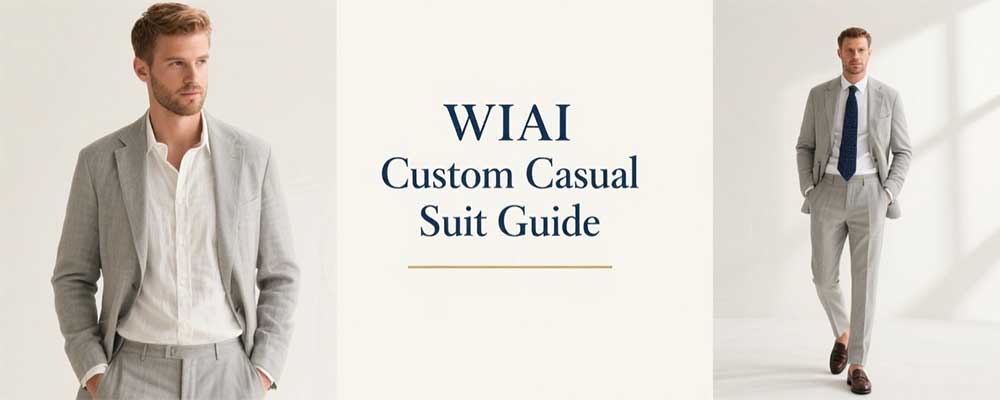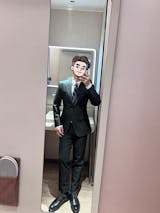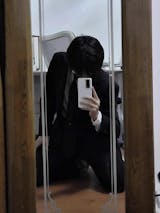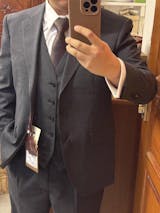
A Guide to Tailored Blazers: The Perfect Blend of Elegance and Practicality
A lounge suit, a garment that combines formal elegance with everyday practicality, showcases the wearer's taste and style in a wide range of occasions. As a brand specializing in custom-made suits, WIAI understands the allure of the lounge suit and is dedicated to creating tailored lounge suits that fit your body perfectly and highlight your personality. Below is a detailed guide to WIAI's custom-made lounge suits.
What is the blazer dress code?
The blazer dress code is one of the most popular, striking the perfect balance between formal elegance and everyday versatility.
At its core, the blazer dress code consists of a matching blazer and trousers, typically paired with a shirt and tie. Unlike casual business attire, the blazer is more formal without being as rigid as a formal dress or tuxedo. It offers the wearer ample room for personalization in terms of color, fabric, and accessories.
The blazer is ideal for a variety of occasions where your look demands a balance of sophistication and approachability. As a harmonious blend between casual workwear and formal black tie attire, the blazer is a must-have for men who appreciate effortless elegance.
The Origin and Evolution of the Leisure Suit
The lounge suit originated in 19th-century Britain as a more relaxed alternative to the formal gowns worn by the upper class. Originally designed as country or casual wear for the elite, it gradually gained popularity due to its comfort and practicality.
By the early 20th century, the lounge suit had become the standard choice for business and formal events. Its evolution was deeply influenced by cultural icons and ever-changing fashion trends. Today, the lounge suit remains a symbol of elegant masculinity, and modern adaptations have enabled it to adapt to a variety of formal and semi-formal occasions while remaining relevant to contemporary styles.
Core items of the casual suit dress code
When choosing a casual suit, don't just focus on the jacket and trousers; other elements also play a vital role in creating a perfectly balanced look. Here are the pieces you need to bring to this dress code.
Suits: The foundation of the dress code
Yes, this is the foundation of the casual suit dress code. A classic casual suit consists of a blazer and matching trousers in the same color and texture, creating a coordinated look.
There are a variety of suit types available, including two-piece and three-piece suits. A two-piece suit is a timeless choice, while a three-piece suit adds a waistcoat for a more formal look. Additionally, you can explore different styles, such as single-breasted suits, which are versatile and modern, and double-breasted suits, which convey a more traditional and prestigious feel.
Wear a shirt underneath
The shirt is another essential component of a casual suit. For a timeless look, opt for a crisp white shirt, which pairs beautifully with any suit color. Light blues and pastels are also great options, adding a subtle pop of color.
When choosing a shirt, consider the collar style. A spread collar lends itself to a variety of tie knots, while a peak collar is more traditional and simple. Your shirt should complement your tie and jacket to create a seamless overall look.
Ties: A touch of vibrant color
A tie is the ultimate accessory that ties your outfit together. When choosing a tie for your casual suit, focus on complementary colors and patterns. For example, a navy suit pairs well with a burgundy or patterned tie, while a charcoal gray suit can be enhanced with a striped or silver tie.
Avoid overly bold or eye-catching patterns. Instead, opt for solid colors or ties with subtle checks, plaids, and stripes. Silk ties are a classic choice, adding just the right amount of shine and elegance to elevate your look.
Improve overall coordination
Shoes contribute significantly to the coordination of a casual suit. Oxfords, derbies, or loafers are the best choices, as they always add a touch of sophistication to your outfit.
Black leather Oxfords are the safest and most versatile choice for formal occasions, while brown loafers or derbies can add warmth and personality to a lighter-colored suit.
Make sure your shoes are polished and match the hue of your suit. A blue or gray suit can be paired with brown shoes for a touch of contrast; a black suit should always be paired with a sleek black shoe.
How to create a casual suit look?
Styling a casual suit is all about balancing tradition with personal style. Here's a detailed guide to mastering the art of styling a casual suit, taking into account all the details that make up a sophisticated look.
Choose the right cut
The cut of a casual suit can make or break the entire look. Whether you prefer a slim, regular, or modern cut, the key is to ensure the suit fits your body type and personal style.
- Slim Fit: Designed for a modern look, slim-fit suits feature narrower lapels, tapered trousers, and a close-fitting chest and waist. They're best suited for men with slim or athletic builds, perfect for projecting a professional look and modern events.
- RegularFit: A classic and comfortable choice, regular-cut suits offer more room in the shoulders, chest, and legs while maintaining a sense of structure. This cut is ideal for those who prefer a classic style or need more room to move.
- Modern Fit: A fusion of slim and regular cuts, modern-cut suits feature a slightly tapered silhouette that flatters most body types. It's versatile enough for most occasions.
In addition, your suit should fit snugly in the shoulders (not sagging or constricting), and the hem of your trousers should barely touch the top of your shoes.
For this reason, a custom fit is the best option. WIAI's custom suits meet this standard as they are designed to your specific measurements and preferences, down to small details like buttons, pockets, and tailoring.
Choosing the perfect fabric
The fabric of a casual suit not only determines its comfort but also its suitability for different times of day. Wool is a top choice for colder months, as it provides warmth and structure. In the summer, lightweight fabrics like linen or cotton are ideal.
Linen suits are breathable and have a slightly textured look, making them perfect for daytime wear. Cotton offers both comfort and elegance, and it's more wrinkle-resistant than pure linen.
The texture of the fabric also influences the overall formality of your look. Smooth, fine wool suits are more formal, while textured fabrics like tweed or herringbone offer more personality and work better in more casual settings.
Explore colors and patterns
When it comes to casual suits, classic colors like navy, gray, black, and charcoal gray offer unparalleled versatility. You can certainly opt for other subdued shades based on your preferences, but it makes sense to stick with darker colors for formal occasions and lighter colors for casual and semi-formal settings. If you're looking for a more versatile style, a casual suit in forest green or burgundy would be a good choice.
If you're looking to add personality to your look, consider a suit with a subtle pattern, not just a tie. For example, pinstripe patterns can elongate your silhouette and add a touch of elegance. Plaid, on the other hand, creates a bolder, more modern look, especially when paired with solid-colored accessories.
Finishing touches: Accessorizing and grooming
A complete casual suit needs the right accessories to complete the look.
- Cufflinks and pocket square: These small details can significantly elevate your suit. A silk pocket square in white or a color or pattern that complements the overall look adds visual interest, while cufflinks add a touch of refined elegance to your shirt cuffs.
- Belt and watch: Choose a sleek leather belt that matches the color of your shoes. A simple watch with a leather or metal strap adds a touch of sophistication without overdoing the look.
Finally, grooming is just as important as the suit itself. Keep your hair neatly combed and your facial hair carefully maintained. A clean, sharp appearance enhances the elegance of your casual suit and ensures you look your best at all times.
When to wear a casual suit?
The casual suit dress code is one of the most versatile options, suitable for a wide range of events. Here's a breakdown of the types of suits you can wear to different occasions.
Formal day events
A blazer is best suited for formal daytime events, such as weddings, christenings, and upscale luncheons. For these occasions, prioritize lightweight fabrics and muted colors, as they convey elegance without being overly formal.
Consider a blazer in light gray or blue, paired with a pale pink shirt and matching tie for an approachable look. For outdoor events like garden weddings, a linen or cotton blend suit offers greater comfort and breathability. Complete the look with leather penny loafers or brogues.
Evening parties and semi-formal occasions
A dark casual suit is a great choice for evening events like cocktail parties, business dinners, or receptions. Opt for darker shades like black or charcoal gray, as they convey a more formal and sophisticated vibe.
Elevate your evening look with eye-catching accessories like a patterned silk tie, pocket square, or cufflinks. Pair it with polished black dress shoes for a classic and eye-catching ensemble. For cocktail events, opt for a corduroy suit for a touch of texture that will help you stand out while still adhering to the dress code.
Business and professional occasions
A casual suit is also a suitable choice for meetings, conferences, or social events. For these occasions, subdued tones and simple patterns can project confidence and professionalism.
A navy suit paired with a light blue shirt and a simple tie creates a clean, sharp look perfect for any corporate setting. Incorporating a classic check pattern adds a touch of personality. Maintain a formal look with polished shoes and a simple watch or leather belt.
The Difference Between Casual Suit Dress Code and Cocktail Attire
While the lounge suit and cocktail attire dress codes may appear similar, they serve different purposes. The lounge suit is slightly more formal and typically worn for daytime or professional events, while cocktail attire is designed for evening gatherings, allowing for more creativity and individuality. While both dress codes call for a refined look, cocktail attire leans towards boldness and glamour.
The main difference lies in the level of formality and styling flexibility. A lounge suit typically features a matching jacket and trousers in classic, subdued hues, paired with a shirt and tie. However, a cocktail suit allows for experimentation with contrasting blazers, bolder patterns, and rich textures like velvet or tweed, making it ideal for receptions and formal parties.








